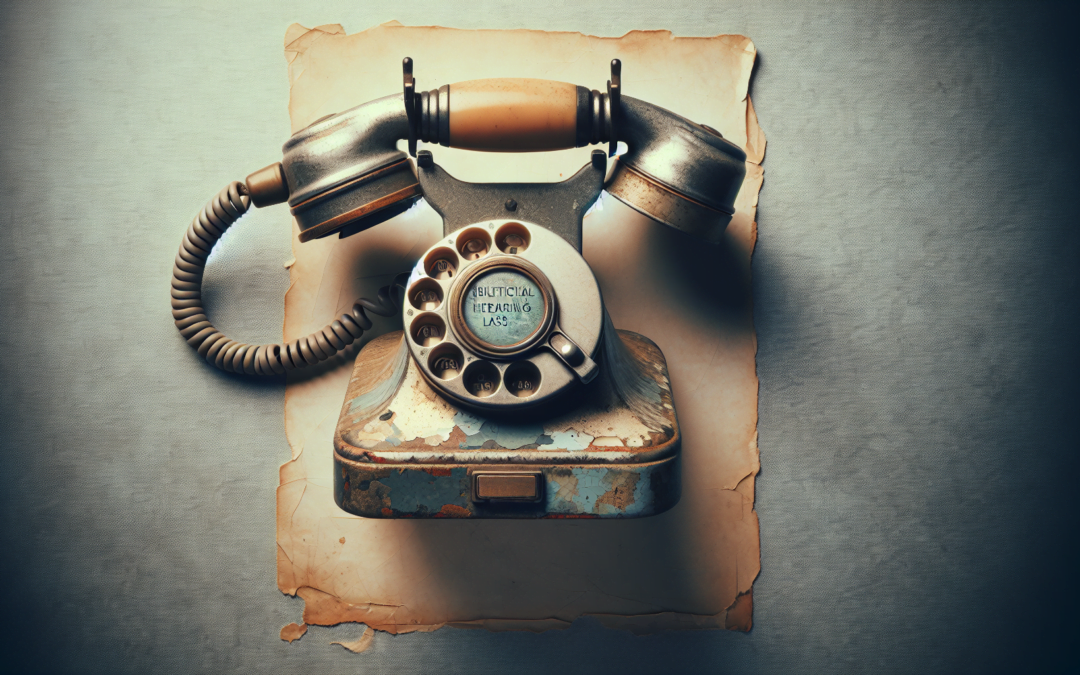Imagine living in a world where everything sounds muffled, conversations become a puzzle of missing pieces, and everyday sounds fade into oblivion. That is the reality for millions of people suffering from bilateral hearing loss, a condition that affects both ears. In this article, we will explore the causes, symptoms, and treatment options for bilateral hearing loss, shedding light on this often misunderstood condition. So, whether you or someone you know is grappling with bilateral hearing loss, buckle up and embark on a journey to gain a deeper understanding of this invisible challenge.
Overview of Bilateral Hearing Loss
Bilateral hearing loss refers to the impairment of hearing in both ears. It can occur at any age and can have various causes. This condition affects the ability to hear sounds and can have a significant impact on communication and daily life. Understanding the different types, symptoms, diagnosis, treatment options, effects, and coping strategies for bilateral hearing loss is crucial for individuals with this condition and their loved ones.
Definition of Bilateral Hearing Loss
Bilateral hearing loss is characterized by the loss of hearing in both ears. It can range from mild to profound and can affect individuals of all ages. This condition can be due to damage to the inner ear, middle ear, or both. It can result from genetic factors, exposure to loud noises, certain medical conditions, infections, medications, or aging.

Prevalence and Causes of Bilateral Hearing Loss
Bilateral hearing loss is relatively common and affects millions of people worldwide. The prevalence varies depending on factors such as age, occupation, and lifestyle choices. Some of the common causes of bilateral hearing loss include inherited genetic conditions, noise-induced damage, ototoxic medications, head trauma, infections, and certain health conditions like Meniere’s disease or autoimmune disorders. It is important to identify the underlying cause to determine appropriate treatment options.
Types of Bilateral Hearing Loss
There are three main types of bilateral hearing loss: sensorineural, conductive, and mixed.
Sensorineural Bilateral Hearing Loss
Sensorineural bilateral hearing loss occurs when there is damage to the inner ear or the auditory nerve. This type of hearing loss is usually permanent and can vary in severity. It can be caused by age-related changes, genetic factors, exposure to loud noises, or certain medical conditions. People with sensorineural bilateral hearing loss may have difficulty hearing conversations, understanding speech, and detecting softer sounds.
Conductive Bilateral Hearing Loss
Conductive bilateral hearing loss occurs when there is an obstruction or damage to the middle ear. This can be due to conditions such as middle ear infections, blockages, or abnormalities in the ear structure. Unlike sensorineural hearing loss, conductive hearing loss is often temporary and can be treated or managed through medical interventions or surgeries.
Mixed Bilateral Hearing Loss
Mixed bilateral hearing loss refers to a combination of sensorineural and conductive hearing loss. It occurs when there is damage to both the outer and middle ear, as well as the inner ear or auditory nerve. This type of hearing loss can be more challenging to treat as it requires addressing both the conductive and sensorineural components.

Symptoms of Bilateral Hearing Loss
Recognizing the symptoms of bilateral hearing loss is crucial for early intervention and management. Some common symptoms include:
Difficulty Hearing Conversations in Noisy Environments
Individuals with bilateral hearing loss may struggle to understand speech in environments with background noise. This can make it challenging to fully participate in conversations, especially in crowded places, restaurants, or social gatherings.
Struggling to Locate the Source of a Sound
Determining the direction or source of a sound can be difficult for individuals with bilateral hearing loss. This can cause confusion or the inability to respond appropriately to auditory cues.
Misunderstanding Speech and Asking for Repetition
Bilateral hearing loss can result in difficulties in speech comprehension, leading to miscommunication and the need to ask others to repeat themselves frequently. This can impact social interactions and undermine self-confidence.
Diagnosis of Bilateral Hearing Loss
Proper diagnosis of bilateral hearing loss involves a comprehensive assessment. The following methods are commonly used:
Medical History and Physical Examination
The healthcare professional will inquire about the patient’s medical history, including any past or current medical conditions, medications, or exposure to loud noises. A physical examination of the ears and related structures will be conducted to identify any visible abnormalities or potential causes.
Audiometry Tests
Audiometry tests are essential in diagnosing bilateral hearing loss. These tests measure the individual’s ability to hear different frequencies and intensities. Pure-tone audiometry, speech audiometry, and tympanometry are some of the commonly used tests to evaluate the severity and type of hearing loss.
Other Diagnostic Procedures
In some cases, additional diagnostic procedures may be required to determine the underlying cause of bilateral hearing loss. These may include imaging tests, genetic testing, or specialized assessments by otolaryngologists or audiologists.

Treatment Options for Bilateral Hearing Loss
Several treatment options are available to help individuals with bilateral hearing loss improve their hearing and enhance their quality of life.
Hearing Aids
Hearing aids are commonly prescribed for individuals with bilateral hearing loss, especially those with sensorineural hearing loss. These devices amplify sounds and improve the individual’s ability to hear and understand speech. Advances in technology have led to the development of smaller and more discreet hearing aids with improved features and connectivity options.
Cochlear Implants
Cochlear implants are electronic devices surgically implanted in the inner ear to provide sound signals to the brain. They are primarily used for individuals with severe to profound sensorineural hearing loss who do not benefit from hearing aids. Cochlear implants can significantly improve speech perception and communication abilities.
Assistive Listening Devices
Assistive listening devices, such as FM systems, loop systems, or captioning services, can be beneficial for individuals with bilateral hearing loss. These devices amplify sound and improve listening experiences in specific situations, such as listening to the television, attending meetings, or participating in group conversations.
Effects of Bilateral Hearing Loss
Bilateral hearing loss can have various effects on individuals’ lives beyond just the impairment of hearing. Understanding these effects is crucial to provide appropriate support and intervention.
Impact on Speech and Language Development
In children, bilateral hearing loss can significantly impact speech and language development. Difficulties in hearing and understanding speech can delay language acquisition and affect educational progress. Early interventions, such as hearing aids or cochlear implants, along with speech therapy, can help minimize these effects.
Social and Emotional Consequences
Bilateral hearing loss can lead to social and emotional challenges. Individuals may experience feelings of isolation, frustration, or embarrassment due to difficulties in communicating effectively. Support from family, friends, and professionals, along with participation in hearing loss support groups, can provide much-needed emotional support and encouragement.
Educational Challenges
Children and adults with bilateral hearing loss may face educational challenges. It may be necessary to provide accommodations in the classroom, such as preferential seating, note-taking assistance, or the use of assistive listening devices. Effective communication strategies and collaboration with educators can help individuals with bilateral hearing loss succeed academically.
Communication Strategies for Bilateral Hearing Loss
Adopting effective communication strategies can greatly improve interactions and understanding for individuals with bilateral hearing loss. Both the person with hearing loss and their communication partners can implement these strategies.
Tips for Communication Partners
Communication partners can make a significant difference by following a few simple tips. These include facing the person directly, speaking clearly and at a moderate pace, using natural gestures and expressions, minimizing background noise, and being patient and understanding.
Use of Visual Cues and Gestures
Visual cues and gestures can enhance communication for individuals with bilateral hearing loss. This can include using facial expressions, body language, and hand gestures to supplement verbal communication. Lip-reading and sign language may also be helpful.
Advocating for Hearing Accessibility
Advocating for hearing accessibility in various settings is crucial to ensure equal participation and inclusivity for individuals with bilateral hearing loss. This can involve raising awareness about the importance of accommodations, such as captioning services, looping systems, or the provision of assistive listening devices.
Living with Bilateral Hearing Loss
Learning to live with bilateral hearing loss involves various aspects, including seeking support, developing coping strategies, and prioritizing self-care.
Support Networks and Resources
Joining support networks and organizations dedicated to hearing loss can provide individuals with bilateral hearing loss a sense of community and access to valuable resources. Online forums, local support groups, and hearing loss associations can offer guidance, information, and emotional support.
Coping Strategies
Developing coping strategies can help individuals manage the challenges associated with bilateral hearing loss. This may include practicing active listening techniques, using note-taking apps, employing time-management strategies, and maintaining open communication with family, friends, and colleagues.
Self-Care and Management
Taking care of one’s physical and mental well-being is essential for individuals with bilateral hearing loss. This involves getting regular exercise, maintaining a healthy lifestyle, managing stress levels, and seeking professional help if needed. Regular appointments with an audiologist to monitor hearing health and effectiveness of treatment options are also important.
Prevention and Protection for Bilateral Hearing Loss
While some causes of bilateral hearing loss cannot be prevented, there are steps individuals can take to protect their hearing and minimize the risk of developing this condition.
Importance of Hearing Protection
Wearing hearing protection, such as earplugs or earmuffs, is crucial in environments with loud noises. This includes workplaces with industrial machinery, concerts or sporting events, and other recreational activities involving loud noises. Protecting the ears from excessive noise can prevent damage to the auditory system.
Avoiding Prolonged Exposure to Loud Noises
Limiting exposure to loud noises, particularly for an extended period, can help prevent bilateral hearing loss. Taking breaks from noisy environments, reducing the volume levels on personal devices, and moving away from loud speakers are simple yet effective ways to protect the ears.
Regular Hearing Screenings
Regular hearing screenings are vital, even for individuals without any apparent hearing problems. Early detection of hearing loss can lead to timely interventions and better outcomes. Consulting an audiologist for regular check-ups can help monitor hearing health and address any concerns promptly.
Research and Developments in Bilateral Hearing Loss
Ongoing research and advancements in the field of bilateral hearing loss offer hope for improved treatment options and outcomes.
Advances in Hearing Aid Technology
Continuous developments in hearing aid technology have resulted in more sophisticated and effective devices. Modern hearing aids are smaller, more discreet, and offer features such as Bluetooth connectivity, noise reduction, and directional microphones. These advancements strive to provide individuals with bilateral hearing loss a better listening experience and improved quality of life.
Studies on the Effectiveness of Intervention Methods
Numerous studies are being conducted to evaluate the effectiveness of intervention methods, including hearing aids, cochlear implants, and assistive listening devices. These studies aim to further refine existing treatments, identify optimal strategies for different populations, and explore potential future advancements.
Future Prospects for Treatment
Researchers are actively exploring innovative approaches for treating bilateral hearing loss. This includes ongoing studies on gene therapy, stem cell therapy, and regenerative medicine aimed at restoring or enhancing hearing function. While these treatments are still in the experimental stage, they hold promise for the future of hearing loss management.
In conclusion, bilateral hearing loss is a complex condition that can significantly impact an individual’s life. Understanding the different types, causes, symptoms, diagnosis, treatment options, effects, and coping strategies is essential for those living with this condition and their support networks. By raising awareness, advocating for hearing accessibility, and embracing advancements in technology and research, individuals with bilateral hearing loss can lead fulfilling lives and overcome the challenges they may encounter.
